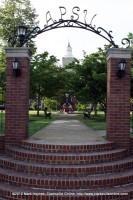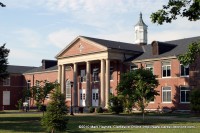 Tyler Saunders, a high school student from Dover, was walking across the Austin Peay State University campus last summer when a poster advertising the upcoming Governor’s School in Computational Physics caught his eye.
Tyler Saunders, a high school student from Dover, was walking across the Austin Peay State University campus last summer when a poster advertising the upcoming Governor’s School in Computational Physics caught his eye.
The highly competitive program, which has been at APSU for three years, is geared toward hardworking high school sophomores and juniors with an interest in engineering, mathematics and science, and allows them to earn seven hours of college credit. The Governor’s School in Computational Physics (GSCP) seeks only the best and brightest students in the state, and Saunders was intrigued by the poster he saw for it.
“It made me want to do it,” he said. “I honestly didn’t know it had anything to do with computers and stuff. I was pleasantly surprised when I came in and found I would be learning all this cool stuff.”
On a hot afternoon in late May, Saunders returned to the APSU campus as one of only 38 students from across Tennessee to participate in the GSCP program. Immediately, he was handed a small, inexpensive netbook computer with his name and APSU engraved in a plate on the cover.
“Everyone got one,” Dr. Jaime Taylor, dean of the APSU College of Science and Mathematics, said. “The netbooks dramatically change the way we teach. After class, the students can take them back to their room, do their homework.”
Saunders took his new netbook that afternoon and quickly found his way to his dorm room. He knew his way pretty well around campus. For the previous two summers, he was a student in APSU’s Science and Math Academy – a free two-week summer program designed to sharpen the math and science skills of local high school students. It was an experience that prepared him to be one of the elite few students in Tennessee to attend the GSCP program at APSU.
 “It (Science and Math Academy) was really strong in algebra, and that helped me in school and also helped me here with all the calculus I never even heard of,” he said.
“It (Science and Math Academy) was really strong in algebra, and that helped me in school and also helped me here with all the calculus I never even heard of,” he said.
The work he’s doing at the Governor’s School is at a higher level than what most high school students find in their classrooms back home. The students tackle concepts even their teachers might not be familiar with.
“What we hope happens is they’ll take this back to their school,” Taylor said. “They’re going to know more than their math and physics teachers at their school. Numerical Methods is typically not taught at the undergraduate level, so their math and physics teachers aren’t going to know how to do this. They’ll be able to go back and teach their teachers and fellow students the numerical methods.”
Many of the students come to campus for the Governor’s School as blank slates, not knowing a thing about computational physics. Rebecca Sadowitz arrived from Chattanooga with an interest in science (as well as music and art), unsure how to use her new netbook to solve problems that are near indecipherable using traditional mathematics.
 “I feel this has really helped me grow as a person and also understand what college life is really like,” she said. “I’m learning a lot of stuff, particularly in the programming. I had absolutely no knowledge of it.”
“I feel this has really helped me grow as a person and also understand what college life is really like,” she said. “I’m learning a lot of stuff, particularly in the programming. I had absolutely no knowledge of it.”
Now, students like Sadowitz and Saunders are taking their netbook computers with them even during their off hours to practice what they’ve learned so far.
“That’s how they socialize,” Taylor joked. “They say ‘let’s get together and do homework.’”


